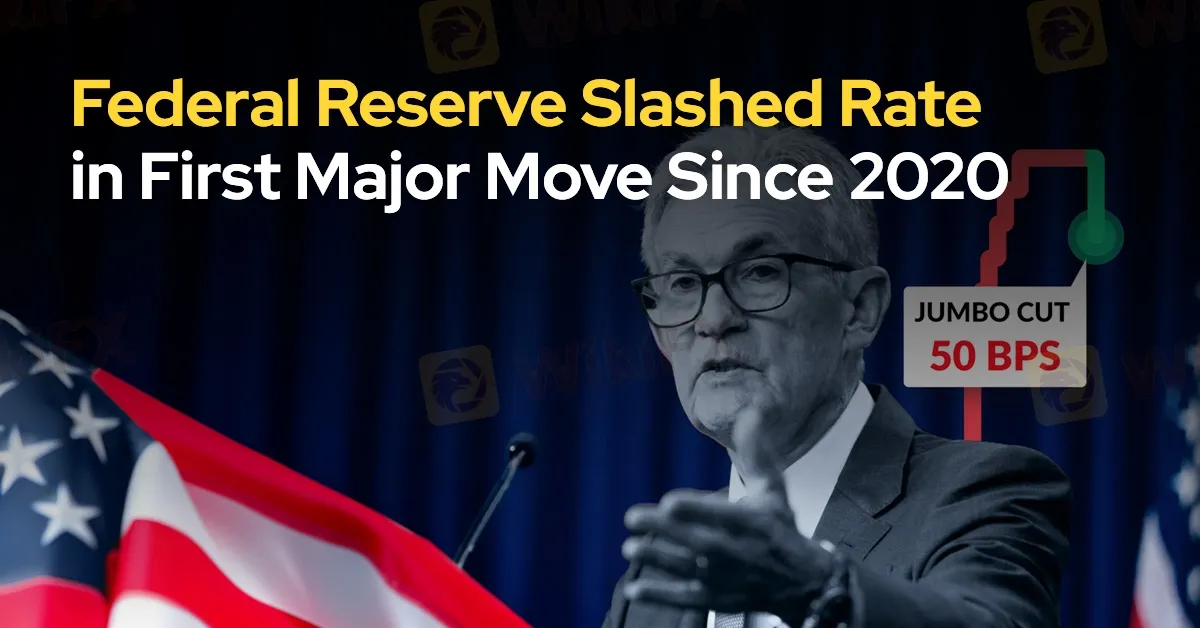简体中文
繁體中文
English
Pусский
日本語
ภาษาไทย
Tiếng Việt
Bahasa Indonesia
Español
हिन्दी
Filippiiniläinen
Français
Deutsch
Português
Türkçe
한국어
العربية
Federal Reserve Slashed Rate in First Major Move Since 2020
Abstract:The U.S. Federal Reserve has made its first interest rate cut in over four years, lowering the benchmark rate by half a percentage point. This significant reduction, which exceeds the typical quarter-point adjustments, signals growing concerns within the central bank about its ability to maintain control over inflation.

The U.S. Federal Reserve has made its first interest rate cut in over four years, lowering the benchmark rate by half a percentage point. This significant reduction, which exceeds the typical quarter-point adjustments, signals growing concerns within the central bank about its ability to maintain control over inflation. The Federal Open Market Committee (FOMC) has been focused on ensuring that inflation remains manageable while promoting maximum employment.
According to the Federal Reserve, the committee is working to achieve its long-term goals of 2% inflation and full employment. The FOMC indicated increased confidence that inflation is trending sustainably toward the 2% target, though it acknowledged that balancing these objectives continues to pose risks. The rate cut brings the federal funds rate to a range of 4.75% to 5%, signalling the beginning of the first easing cycle since the pandemic began in 2020.
The decision to cut rates comes after a period of more than two years of aggressive rate hikes aimed at combating inflation. Inflation had surged to 7% in 2022, but by July 2024, it had moderated to 2.5%. The Federal Reserve‘s recent statements reflect optimism regarding inflation’s trajectory, though the issue has not been fully resolved. Despite the reduction, inflation remains a pressing concern, according to a report by the Financial Times.

While the Federal Reserve has expressed confidence in the progress made toward achieving its inflation target, the decision to implement a half-point cut was not without controversy. Michelle Bowman, a member of the FOMC, reportedly opposed the decision, favouring a smaller, quarter-point reduction. Bowman's dissent marked a notable departure, as it was the first time a Fed governor had opposed a rate decision since 2005, according to CNN.
Economic analysts believe that the Federal Reserves decision could have wide-reaching effects on both the U.S. and global economies. Over the past few years, inflation was driven to a 40-year high due to pandemic-related disruptions and subsequent policy measures. With inflation now showing signs of moderation, the large rate cut may influence international markets. According to Reuters, the move is expected to impact currency valuations and global economic conditions, as such decisions often reverberate through the financial system.
The timing of the rate cut, coinciding with the buildup to the U.S. presidential election, adds another dimension to the economic landscape. The Federal Reserves actions may become a focal point in discussions around economic management, potentially influencing public perceptions of both inflation and cost-of-living issues. The scale of this reduction could also become a point of debate as political stakeholders weigh in on the broader implications for the U.S. economy.

Disclaimer:
The views in this article only represent the author's personal views, and do not constitute investment advice on this platform. This platform does not guarantee the accuracy, completeness and timeliness of the information in the article, and will not be liable for any loss caused by the use of or reliance on the information in the article.
Read more

Malaysian-Thai Fraud Syndicate Dismantled, Millions in Losses Reported
The Royal Malaysia Police (PDRM) has received 26 reports concerning the Nicshare and CommonApps investment schemes, both linked to a major fraudulent syndicate led by a Malaysian citizen. The syndicate’s activities came to light following the arrest of its leader by Thai authorities on 16 December.

WikiFX Review: Is FxPro Reliable?
Founded in 2006, FxPro is a reputable UK-based broker, trading on various market instruments. In this article, we will help you find the answer to one question: Is FxPro reliable?

SEC Approves Hashdex and Franklin Crypto ETFs on Nasdaq
The SEC has approved crypto index ETFs by Hashdex and Franklin Templeton, including Bitcoin and Ethereum, marking a milestone in crypto asset investment.

North Korean Hackers Steal $1.3bn in Cryptocurrency in 2024
Over $2.2bn in cryptocurrency stolen in 2024, with North Korean hackers accounting for $1.3bn. Discover how cyber theft impacts the evolving crypto landscape.
WikiFX Broker
Latest News
Top 10 Trading Indicators Every Forex Trader Should Know
ASIC Sues Binance Australia Derivatives for Misclassifying Retail Clients
WikiFX Review: Is FxPro Reliable?
Malaysian-Thai Fraud Syndicate Dismantled, Millions in Losses Reported
Trading frauds topped the list of scams in India- Report Reveals
WikiFX Review: Something You Need to Know About Markets4you
Revolut Leads UK Neobanks in the Digital Banking Revolution
Fusion Markets: Safe Choice or Scam to Avoid?
SEC Approves Hashdex and Franklin Crypto ETFs on Nasdaq
Malaysian Pensioner Loses RM823,000 in Fake Investment Scam
Currency Calculator


